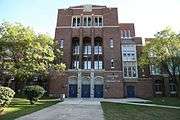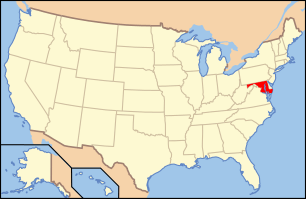Frederick Douglass High School (Baltimore, Maryland)
| Frederick Douglass High School | |
|---|---|
|
"Continuing the Tradition with Pride, Dignity, and Excellence" | |
| Address | |
|
2301 Gwynns Falls Parkway Baltimore, Maryland 21217 | |
| Coordinates | 39°18′53″N 76°39′18″W / 39.3148°N 76.6549°WCoordinates: 39°18′53″N 76°39′18″W / 39.3148°N 76.6549°W |
| Information | |
| School type | Public, Comprehensive |
| Founded | 1883 |
| School district | Baltimore City Public Schools |
| Superintendent | Dr. Gregory Thornton [CEO] |
| School number | 450 |
| Principal | Patricia Hunter |
| Grades | 9–12 |
| Enrollment | 886[1] (2014) |
| Area | Urban |
| Color(s) | Dark Blue and Orange |
| Mascot | The Mighty Ducks |
| Team name |
The Mighty Ducks (for boys) Lady Ducks (for girls) |
| Website |
www |
Frederick Douglass High School is a public high school located in Baltimore, Maryland.
Founded in 1883, established as the Colored High and Training School, Douglass is the second oldest historically integrated public high school in the United States.[2] Prior to desegregation Douglass and Baltimore's Paul Laurence Dunbar High School were the only two high schools in Baltimore that admitted African American students. Douglass served African American students from west Baltimore, while Dunbar served students from east Baltimore. Among Douglass' most notable alumni is Supreme Court Justice Thurgood Marshall.[3] A graduate of the class of 1926, in 1954 Marshall successfully challenged school segregation as a lawyer in the case of Brown v. Board of Education, in which the Supreme Court ruled that separate but equal in public education was unconstitutional because it could never truly be equal. The school remains overwhelmingly majority African American and Douglass is one of the eleven lowest performing schools in the state of Maryland.[4]
History
|
Frederick Douglass High School | |
   | |
| Location | 1601 North Calhoun Street, Baltimore, Maryland |
|---|---|
| Coordinates | 39°18′27″N 76°38′33″W / 39.3075°N 76.6424°W |
| Area | 3 acres (1.2 ha) |
| Architect | Owens & Sisco |
| Architectural style | Late Gothic Revival |
| NRHP Reference # | 89000412[5] |
| Added to NRHP | May 18, 1989 |
Named the "Colored High and Training School," Douglass was founded in 1883, six years later located on East Saratoga Street near St. Paul Street (present-day Preston Gardens near the former Douglass Institute of 1865 and Newton University on East Lexington Street, two blocks to the southeast for free blacks/freeman. It was the only high school for African-Americans in the City of Baltimore until Paul Laurence Dunbar High School opened its doors in 1937 off Orleans Street in East Baltimore, developing from an elementary school (1918) and junior high school (1925). On June 22, 1894, Frederick Douglass gave a commencement address at the school in which he said:
"The colored people of this country have, I think, made a great mistake, of late, in saying so much of race and color as a basis of their claims to justice, and as the chief motive of their efforts and action. I have always attached more importance to manhood than to mere identity with any variety of the human family..." "We should never forget that the ablest and most eloquent voices ever raised in behalf of the black man’s cause were the voices of white men. Not for race, not for color, but for men and for manhood they labored, fought, and died. Away, then, with the nonsense that a man must be black to be true to the rights of black men."[6]
In 1900, the school moved from East Saratoga Street near North Charles Street and St. Paul Street, where it had been housed since 1889, to a building on the corner of Dolphin Street and Pennsylvania Avenue.[7] In 1900, the Baltimore City Public School System initiated a one-year training course for African American elementary school teachers. As a result, Coppin State University, an HBCU Historically Black Colleges and Universities was founded at Douglass High School. In 1907, Coppin appointed its own principal and formally separated from the high school. In 1938, the curriculum was lengthened to four years and the college began to grant Bachelor of Science degrees.[8] In 1925, the school's name was formally changed to Frederick Douglass High School. The name change was the result of the subsequent move to the school's third location a new site at Calhoun and Baker Streets. That same year, the first class entered the new institution and for the first time in Baltimore, black students had a gymnasium, a library, and cafeteria. Douglass has produced dozens of notable alumni including civil rights activists Clarence M. Mitchell, Jr., Juanita Jackson Mitchell, Lillie Mae Carroll Jackson and jazz legends Cab Calloway., Ethel Ennis, The Ink Spots lead singer Bill Kenny, and opera star Veronica Tyler. Douglass High is currently located since 1954 on Gwynn's Fall Parkway near Mondawmin Mall in the old Western High School building, constructed 1928, (a twin of the old Eastern High School building on East 33rd Street and Loch Raven Boulevard in Northeast Baltimore, across from Baltimore City College) across the street from Coppin State College's campus.
In 2008, Frederick Douglass was the subject of an HBO documentary: Hard Times at Douglass High: A No Child Left Behind Report Card directed by Oscar award winning filmmakers Alan Raymond and Susan Raymond, which was recorded in the 2004 - 2005 school year, highlights the past academic and financial struggles of the school under the No Child Left Behind Act.
Demographics
Douglass high school, as of 2007, had 1,151 students, of which 52% were female. African American students made up 99% of the total student population with 53% qualifying for free lunch. The school has 59 teachers for a 1:20 teacher per pupil ratio.[9] The breakdown of students per grade was:
- Grade 9 - 491 students
- Grade 10 - 233 students
- Grade 11 - 212 students
- Grade 12 - 215 students
Notable alumni
- Clarence W. Blount, first African American Majority leader (1983–2003), Maryland State Senate
- Frank Boston, Member, Maryland House of Delegates (1987-1999)
- Roger W. Brown, Judge, Circuit Court for Baltimore City (1987–2002)
- Cab Calloway, jazz singer, band leader
- Paula Campbell, recording artist
- Harry A. Cole, first African-American elected to the Maryland General Assembly
- Ethel Ennis, jazz singer
- Elton Fax, illustrator
- Dru Hill, R&B recording group
- Lillie Mae Carroll Jackson, veteran civil rights activist, founder Baltimore branch NAACP
Terry Johnson, The Flamingos- Lead singer
- Bill Kenny, The Ink Spots- Lead singer
- Labtekwon, hip hop artist
- Thurgood Marshall, Justice, U.S. Supreme Court
- Kweisi Mfume, U.S. Congressman (1987–1996), former President/CEO, National Association for the Advancement of Colored People (NAACP)
- Clarence M. Mitchell, Jr., civil rights activist, namesake Clarence M. Mitchell, Jr. Courthouse
- Juanita Jackson Mitchell, civil rights activist, lawyer, first African American female to practice law in Maryland
- Parren Mitchell, U.S. Congressman (1971–1987)
- Margaret "Peggy" Murphy, first black woman to chair the Baltimore City Delegation
- Alfred Prettyman, philosopher
- Pete Rawlings, Appropriations chairman, Maryland House of Delegates
- Bishop L. Robinson, First African American police commissioner of Baltimore, Maryland[10]
- Frederick Isadore Scott, First African American undergraduate admitted to Johns Hopkins University, First African American undergraduate graduate of Johns Hopkins University
Gallery
-
Frederick Douglas High School
-

Frederick Douglas High School, September 2016
-

Douglass High School, May 2008
References
- ↑ "Enrollment for All Grades All Students : Demographics : Baltimore City - Frederick Douglass High : 2014 Maryland Report Card:". Maryland State Department of Education. Retrieved July 27, 2014.
- ↑ "Film shows Baltimore school struggling despite No Child Left Behind law". Associated Press. June 21, 2008. Retrieved January 24, 2009.
- ↑ Wiltz, Teresa (June 23, 2008). "The ABCs of Failure". The Washington Post. Retrieved June 27, 2008.
- ↑ Neufield, Sara. "A Realistic Portrait of Frederick Douglass High". Baltimore Sun. Retrieved June 27, 2008.
- ↑ National Park Service (2009-03-13). "National Register Information System". National Register of Historic Places. National Park Service.
- ↑ "Frederick Douglass". About Famous People. Retrieved June 26, 2008.
- ↑ Mark R. Heckman (June 1988). "National Register of Historic Places Registration: Frederick Douglass High School" (PDF). Maryland Historical Trust. Retrieved 2016-04-01.
- ↑ "Black History". BACVA. Retrieved June 27, 2008.
- ↑ "Frederick Douglass High School". 2003- 2008 Public School Review. Retrieved June 26, 2008.
- ↑ "When it's Broken, You've Got to Fix It". University of Baltimore. Retrieved June 23, 2012.
External links
- Frederick Douglass High School
- Frederick Douglass High School - Maryland Report Card
- Hard Times at Douglass High - film
- Frederick Douglass High School, Baltimore City, including photo from 2003, at Maryland Historical Trust


